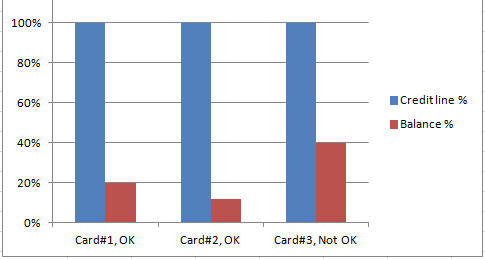The Ratio of Amount Owed to the Credit Line
accounts for 30% of your Credit Score. This
Ratio measures how you manage your finances and
plan for crises. Amount Owed here is not about
the dollar amount you are borrowing, it is about
the dollar amount you are borrowing relative to
the amount available to you.
Figure
4: Ratio of Amount
Owed to Credit Line should be Less than 30 Percent

TIPS:
Keep the Ratio of Amount Owed to the Credit Line
(AO/CL) Less than 30% for each credit or charge card
individually and for all cards combined. See example
below:
|
Credit Card |
Credit Line |
Current Balance |
Amount Owed/Credit Line % |
|
Card#1 |
$5000 |
$1000 |
20% OK |
|
Card#2 |
$1000 |
$400 |
40%
Not OK |
|
Total |
$6000 |
$1400 |
23.3% OK |
1.
You should have a good cushion of available
credit between your current balance and your credit
limits on all open trades. This will have a positive
effect on your credit score. This cushion shows
lenders that you are unlikely to overextend yourself
financially.
2.
The ratio of Amount Owed to Credit Line
should be less than 33% for each credit or charge
card individually and for all cards combined. The
lesser the ratio, the better the score. For example,
carrying a $400 balance on a $1000-Limit credit card
is bad for your credit score (AO/CL=40%). Whereas,
carrying a $1000 balance on a $5000-Limit credit
card is OK for your credit score (AO/CL=20%).
3.
If you are buying a home sometime soon, don’t
be tempted to open a store charge card to receive
discounts. Though, these discounts can be huge,
sometimes up to 25% of your purchases on the first
day, usually you will be approved for a couple of
hundred dollars more than what you plan to buy. This
purchase will cause to nearly max-out your line of
credit.
For example if you plan to buy a couch that cost
about $1200, you may be awarded a credit line of
$1500, in which case your (Amount Owed)/(Credit
Line) ratio becomes 80% or about 88% including sales
tax (almost maxed-out). This will have a negative
impact on your credit score.
4.
Not all creditors, lenders, etc will send
their reports to all credit bureaus on the same day
and/or time. If you or your creditor runs your
report today at 10:00 AM, your credit reports and
credit scores could well be different than the
reports and scores if they run it a few hours later
on the same day.

Try to find out, if you can, from each of your
creditors when they send their monthly reports to
the credit bureaus. Then, plan ahead and pay as much
as possible, e.g., 1 week before the reporting day,
to reduce or pay off your balance.
5.
Time-by-time, request a soft credit line
increase. Typically, creditors can increase your
line of credit a couple of hundred or thousand
dollars without running your credit report, if you
have a good past record or relationship with them
for a year or more. If your line of credit is
increased, you’re (Amount Owed)/(Credit Line) ratio
decreases and that is good for your credit score.
 HOW to overcome the problems with your credit
history and credit score?
HOW to overcome the problems with your credit
history and credit score?
Knowledge, education, awareness, practice and
discipline are the essential keys to being
successful on any subject. The book,
"Credit Score Tips and Tricks",
provides you information, tools, techniques to
educate yourself and manage your credit report &
credit score, and therefore manage your finances
effectively at no additional cost.
I have decided to bring and share with you,
chapters or sections of my book,
Credit Score Tips and Tricks,
as series of
articles here. This is the number
21 of such a
series.
I also created and manage a GROUP in ActiveRain,
Credit Reports and Credit Scores, Please
feel free to join and share your thoughts and
experiences.